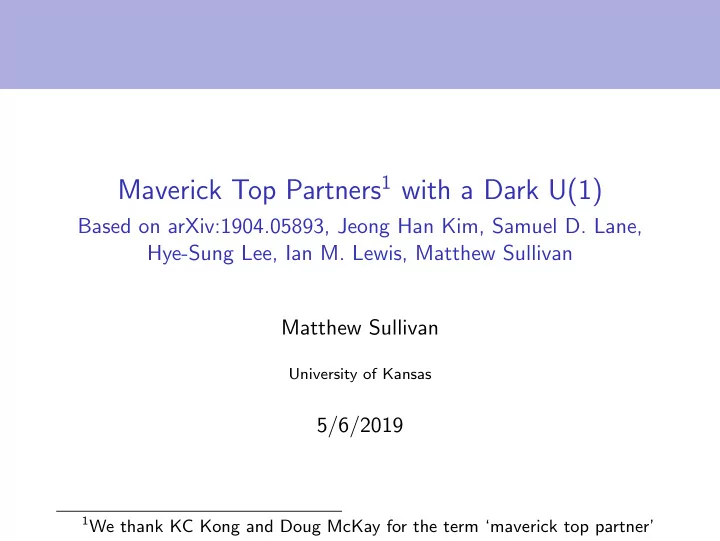

Maverick Top Partners 1 with a Dark U(1) Based on arXiv:1904.05893, Jeong Han Kim, Samuel D. Lane, Hye-Sung Lee, Ian M. Lewis, Matthew Sullivan Matthew Sullivan University of Kansas 5/6/2019 1 We thank KC Kong and Doug McKay for the term ‘maverick top partner’
The Typical Top Partners Top and top partner mass eigenstates will be mixtures of SM-like top and new vector like quark (VLQ) Common in composite Higgs and Little Higgs models VLQ will typically be SU(2) singlets or doublets VLQ is still an SU(3) triplet
Production and Decay Processes of Typical Top Partners Pair production via QCD processes; depends only on mass T T q T q T T T Single production via EW processes; involves mixing and model details u d d u W + W + T T b b Typically decays via electroweak (EW) channels, exact branching ratios depends on model details t t b T T T h 1 Z W +
Harsh Experimental Limits LHC hasn’t seen any top partners! Pair production limits rules out M T � 1 . 1 − 1 . 4 TeV But: limits are for typical electroweak decay channels CMS: J. High Energ. Phys. (2018) 2018: 177 ATLAS: Phys. Rev. Lett. 121, 211801
Getting Around Electroweak Decays ‘Maverick’ top partners decay predominantly via channels other than T → Zt , T → ht , and T → bW Most Many ideas in the literature: gluons, photons, new scalar particles Our idea: dark photon (and dark higgs) decays, T → γ d t and T → h d t t t T T h 2 γ d See also T. Rizzo’s talk
Dark Photon Crash Course Dark matter might interact through new short-ranged forces New fields, dark matter or otherwise, might be charged under such a U (1) d A kinetic mixing term can mix the SM U (1) Y and U (1) d bosons: d ,µν B ′ µν ε ′ θ W B ′ L ⊃ 2 cos ˆ The new ‘dark photon’ gets mass from a dark higgs mechanism For very small mixing, the dark photon inherits couplings to SM fields proportional to electromagnetic charge
Decays of the Maverick Top Partner: Quick Version VLQ is charged under dark U(1) VLQ and SM-like top mix with a mixing angle θ Using the Goldstone equivalence theorem, we can get the widths to the different final states Γ( T → b / t + W / Z / h ) ∼ sin 2 θ M 3 T v 2 EW Γ( T → t + γ d / h d ) ∼ sin 2 θ M 3 T v 2 d We examine dark photon masses M γ d � 10 GeV, naturally expect comparable vev v d � 10 GeV � 2 � Γ( T → t + γ d / h d ) v EW Γ( T → t / b + W / Z / h ) ∼ � O (100) v d Dark decays can easily dominate by orders of magnitude.
Benchmark Model Field Content and Charges SU (3) SU (2) L Y Y d t 1 R 3 1 2/3 0 b R 3 1 -1/3 0 � t 1 L � Q L = 3 2 1/6 0 b L Φ 1 2 1/2 0 2/3 1 t 2 L 3 1 2/3 1 t 2 R 3 1 0 1 H d 1 1 SM-like quarks t 1 R , b R , and Q L t 2 R , t 2 L with same charges is a singlet VLQ Dark higgs H d and SM-like higgs Φ for symmetry breaking in dark and electroweak sectors, resp.
Maverick Top Partner Production ��� � = �� ���� �������� ��� � � � � ] = ��� � / � + ���� ��� [ θ � � ] = ���� � / � + ���� ��� [ θ � � / � + ���� ��� [ θ � � ] = ���� Same story as a ����� � ] = ���� � / � + ���� ��� [ θ � typical top partner σ [ �� ] Pair production ����� depends on mass only Single production is determined by top ����� sector mixing �� - � ��� ��� ���� ���� ���� ���� ���� ���� � � [ ��� ]
Maverick Top Partner Dark Decays �� ( � ⟶ � + � � ) + �� ( � ⟶ � + γ � ) 1000 � ��� 500 ��� ��� ��� ��� ����� ���� [ ��� ] ���� 100 �� ����� 50 � � ����� � ⟶ � � � � ⟶ γ � � ����� � � = � � = ��� ��� � � = � � � ⟶ � � � γ � = � ��� � γ � = � ��� � ⟶ � � � 10 ϵ = ����� ϵ = ����� � ⟶ � � 5 �� - � 500 1000 1500 2000 ��� ���� ���� ���� � � [ ��� ] � � [ ��� ]
Summary and Discussion Current experimental limits strongly constrain mass of typical top partners Maverick top partners with dark decays reopen the low mass region New collider signatures for maverick top partner New avenue for dark photon searches See next talk by Sam Lane for details on the dark photon side
Recommend
More recommend